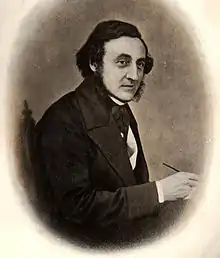Jacob Bell (chemist)
Jacob Bell (5 March 1810 – 12 June 1859) was a British pharmaceutical chemist who worked to reform the profession. He served as a Whig[1][2][3][4] Member of Parliament (MP) for St Albans from 1850 to 1852.
Jacob Bell | |
|---|---|
 Portrait of Jacob Bell | |
| Born | 5 March 1810 London, England |
| Died | 12 June 1859 (aged 49) |
| Political party | Whig |
| Education | Royal Institution; King's College London |
| Scientific career | |
| Institutions | Pharmaceutical Society of Great Britain |
Career
Bell was born in London, one of the six children of John Bell (1774–1849) and Eliza Smith (died 1839), his wife.[5]
On the completion of his education, he joined his father in business as a chemist in Oxford Street, and at the same time attended chemistry lectures at the Royal Institution, and those on medicine at King's College London.[6]
Always keenly alive to the interests of chemists in general, Bell conceived the idea of a society which should at once protect the interests of the trade, and improve its status, and at a public meeting held on 15 April 1841, it was resolved to found the Pharmaceutical Society of Great Britain.
Bell carried his scheme through in the face of many difficulties, and further advanced the cause of pharmacy by establishing the Pharmaceutical Journal, and superintending its publication for eighteen years. The Pharmaceutical Society was incorporated by royal charter in 1843.[6]
One of the first abuses to engage the attention of the new body was the practice of pharmacy by unqualified persons, and in 1845 Bell drew up the draft of a bill to deal with the matter, one of the provisions of which was the recognition of the Pharmaceutical Society as the governing body in all questions connected with pharmacy. For some time after this the question of pharmaceutical legislation was widely discussed.[6]
In December 1850, Bell successfully contested a by-election in the borough of St Albans[1] in order that he might be able to advocate his proposals for reform more effectually in parliament. In 1851 he brought forward a bill embodying these proposals. It passed its second reading, but was considerably whittled down in committee, and when eventually it became law it only partially represented its sponsor's intentions. Bell was the author of an Historical Sketch of the Progress of Pharmacy in Great Britain.
St Albans was disenfranchised for corruption in May 1852, and at the general election in July 1852 Bell stood unsuccessfully in Great Marlow.[7] He stood again one more time, at a by-election in December 1854 for the borough of Marylebone, but did not win the seat.[8]
His brother James was also a Liberal MP, from 1852 to 1857.
He was a friend of Edwin Landseer and a dog-lover: he owned both the dogs in Landseer's famous painting Dignity and Impudence.[9] Bell bought William Powell Frith's painting The Derby Day from the artist in 1858 for £1,500, and left it to the National Gallery on his death in the following year, 12 June 1859.[10]
Notes
- Craig, F. W. S. (1989) [1977]. British parliamentary election results 1832–1885 (2nd ed.). Chichester: Parliamentary Research Services. p. 261. ISBN 0-900178-26-4.
- "St Albans". Newcastle Courant. 27 December 1850. p. 3. Retrieved 12 May 2018 – via British Newspaper Archive.
- "Summary". Liverpool Mercury. 27 December 1850. p. 8. Retrieved 12 May 2018 – via British Newspaper Archive.
- "St. Alban's Election". Northern Star and Leeds General Advertiser. 28 December 1850. p. 17. Retrieved 12 May 2018 – via British Newspaper Archive.
- Information on Jacob Bell's parents from Dictionary of Quaker Biography (typescript at Friends House, Euston) citing Norman Penney Pen pictures (1930) p.111. The siblings of Jacob Bell are listed in a document at Friends House dated 17 November 1825: Eliza, Jacob, Anna, Frederick John and James. John Bell's father-in-law, Frederick Smith ran a successful Chemists business at the Haymarket, which John Bell continued.
- Smith 1885.
- Craig, page 136
- Craig, page 14
- Treuherz, Julian (1993). Victorian Painting. ISBN 9780500202630.
- Chisholm 1911.
References
- Chisholm, Hugh, ed. (1911). . Encyclopædia Britannica (11th ed.). Cambridge University Press.
- Smith, George Barnett (1885). . In Stephen, Leslie (ed.). Dictionary of National Biography. Vol. 4. London: Smith, Elder & Co.
External links
- Works by or about Jacob Bell at Internet Archive
- Hansard 1803–2005: contributions in Parliament by Jacob Bell
- Burnby, Juanita. "Bell, Jacob (1810–1859)". Oxford Dictionary of National Biography (online ed.). Oxford University Press. doi:10.1093/ref:odnb/2006. (Subscription or UK public library membership required.)
- Leigh Rayment's Historical List of MPs – Constituencies beginning with "S" (part 1)